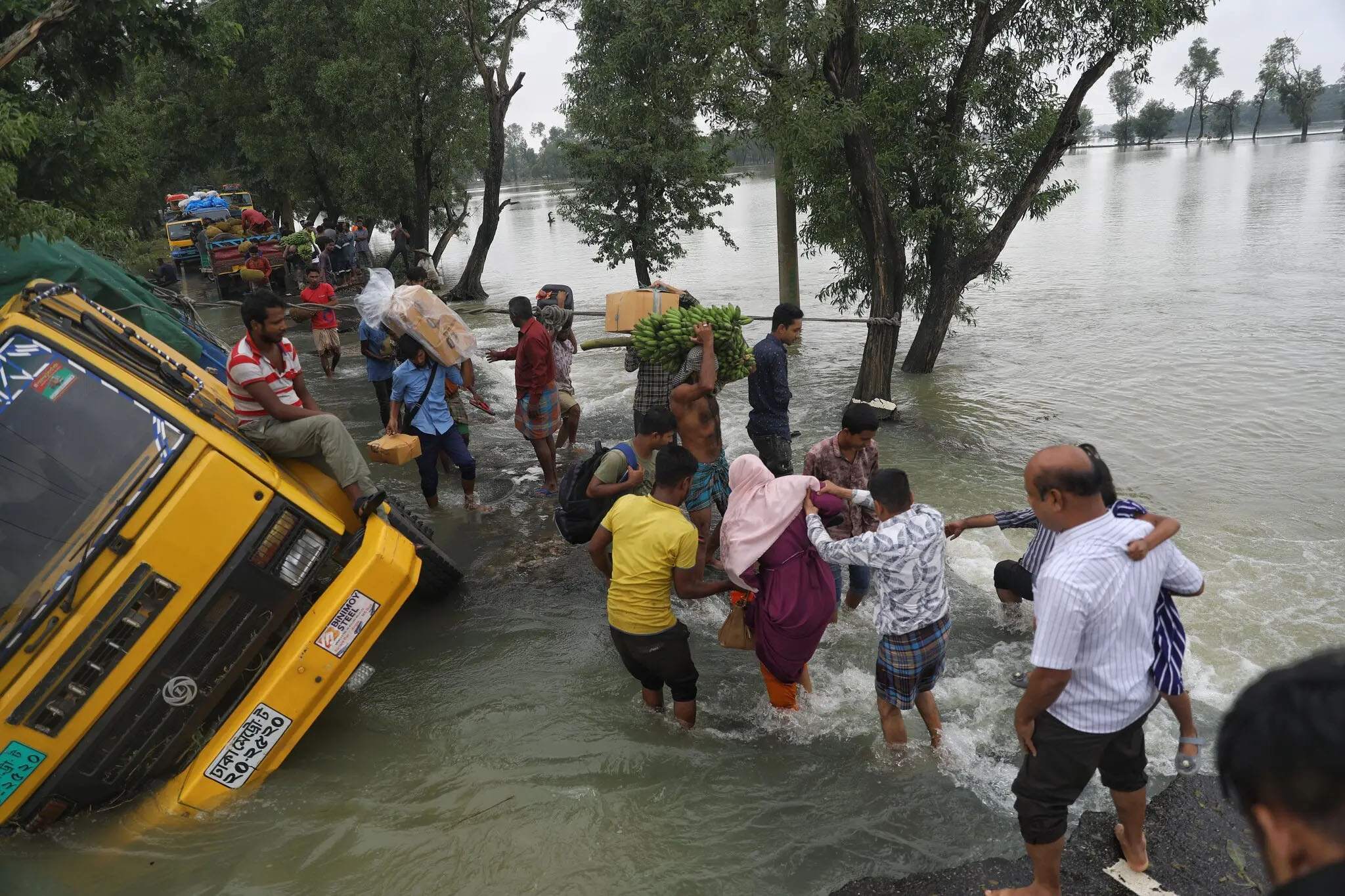It’s been over two months since the devastating floods in Sylhet that saw the displacement of almost 400,000 people, the death of at least 68 people, and the infection of over 4,000 people with waterborne diseases. We have already moved on to other news stories, but it’s probably not so easy for those affected by the floods to move on with their lives.
It’s incredible that even in this day and age, the impact of a flood can be so severe. By June 18, more than 72% of the entire division was under water. People inside and outside Sylhet were at a complete loss. What can you do when you have very little food, no electricity, no means of seeking help, absolutely no certainty whether any help will arrive or not, and are completely surrounded by endless waves of water? What can anyone do?
In a land where natural disasters are quite normal, people somehow manage to go beyond imagination. So did the people in Bangladesh. Help did arrive for the submerged and surrounded people – so many volunteers came forward to help, so many people contributed with whatever donations they could manage.

Still, the devastation that took place is beyond imagination. About 1.6 million children are stranded by the ongoing flood. There have been stories where people died while trying to collect relief sent to them by volunteers and the authority. The helplessness is incomprehensible, the situation had always been bleak, and even though things improved slightly in recent days, nothing is certain as of now. But this also leads to some important questions.
Of course, the flood was horrific. However, was it unavoidable? Was there no better way of dealing with this disaster? Could better preparation for the flood have saved a lot of lives? And most importantly, was only nature to blame for such a disaster?
Rivers and Canals Filled Up, Hills Razed Flat, and Constructions Gone Wrong: Climate Change is Far From Being the Only Reason for this Flood
Dubbing this unprecedented situation as unforeseen and stating that it is the impact of climate change is a very easy way out. However, the horrific impacts of this disastrous flood cannot be attributed solely to climate change. Rather, one can argue that reasons other than climate change might have more to do with the devastating impacts of the flood in Sylhet.
Filling Up Rivers and Haors Is A Major Reason Behind the Worsening the Impacts of Floods
Filling up rivers and canals has been arguably the biggest factor behind this disaster.
The natural water flow through the main two rivers in Sylhet – Surma and Kushiyara – is hindered to a significant extent due to the filling up of these rivers. As the population and the greed of people in Bangladesh continue to increase, river and haor filling continue to become more and more of a frequent occurrence. This practice has become a major issue, since the flow of water going out of Sylhet is facing more and more hindrances through continuously shrinking paths for water flow. Thus, the water stays inside Sylhet for a longer period of time, which is compounded by the seasonal downpour Sylhet faces every year. As a result, the danger of seriously damaging floods continues to increase.
Unfortunately, we had to witness how serious the impact of flood can be if the reckless river and haor filling isn’t stopped in the harshest possible manner. And what’s worse is that most of the people who suffered and died are not the perpetrators.
Rapid Urbanization Causing Worrying Level of Hill Cutting
Another serious issue is the rampant hill cutting that has been going on for decades now. Environmentalists claim that almost half the hillocks in Sylhet have been razed flat over the past two decades. Cutting down hillocks takes place due to the hillock owners’ attempt to sell the flat land to potential home builders. The rapid urbanization taking place in Sylhet is certainly coming at a huge cost. However, the price is not being paid by the ones who are ravaging the hills, but by the ones who hardly have anything to do with this.
Lack of Planned Drainage and Excessive Number of Ill-conceived Infrastructure
It’s almost beyond belief that an area that faces flood every single year does not possess a properly planned drainage system. However, this is true for Sylhet. The seasonal downpour in Meghalaya causes more and more water to come flushing into Sylhet, as well as causing quite frequent landslides. As a result, the drainage areas are often clogged by the incoming mounds of earth. These situations are to be expected in an area like Sylhet, of course. However, no proper planning is existent as of yet to ensure an alternate pathway for the drainage system to function in times of emergency.
Ironically, dams have been one of the reasons for this flood. That is to say, ill-conceived dams, sluice gates etc. have contributed significantly to stopping the outflow of water from Sylhet. Excessive and incessant rain continues to increase the water level of Sylhet. However, the paths for the water to get out were not nearly sufficient.
How Can We Avoid Such Disasters in the Future?

Firstly, we have to accept that the rain will not vanish all of a sudden the next year. The rain, the inflow of water, the landslides – they will continue to take place to different extents in the foreseeable future. They might even get worse given that climate change is unlikely to stop anytime soon – and the worsening nature of climate change will lead to more such problematic situations.
However, does that mean that we can’t do anything to change our fate? Quite the contrary. If enough resources and planning is put to place, then avoiding such horrible disasters will be mostly in our hands. We can’t stop the floods from happening, but we most definitely can control the impacts of floods to a significant extent.
The most crucial step will be to start digging the rivers and canals deeper. Creating more space for water flow is extremely crucial.
At the same time, filling up rivers and canals must be stopped at any cost. Proper implementation of just these two steps will see incredible improvement in terms of future flood situations.
Reducing hillocks to flat land should also be stopped. There are already laws in place, but hillock cutting hasn’t even slowed down due to lack of proper implementation of the laws. Not implementing laws properly is a norm in Bangladesh – and that too in almost every possible pain point that we find in our country. If this practice does not change, then of course, expecting Bangladesh, or Sylhet, to cope better with natural disasters will remain a dream.
And lastly, resources, care, and planning behind the infrastructure and drainage system beg for a significant increase. Dams and sluice gates must be planned in a manner so that water finds a way out of Sylhet instead of getting out of one place and getting stuck in another inside Sylhet. Better drainage systems must be built, and rivers and haors should be dug in a manner so that the outflow of water is ensured.
Ultimately, we can’t expect a miracle to take place to get rid of future floods altogether. However, exactly how much they can impact us stays, to a significant extent, in our hands.






